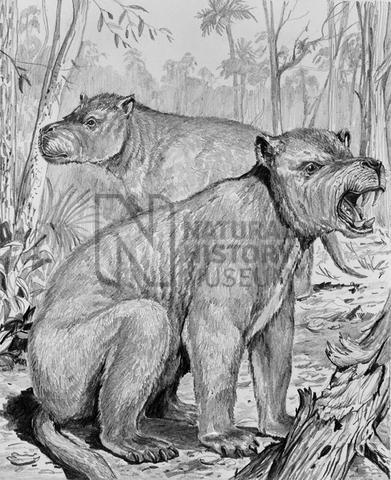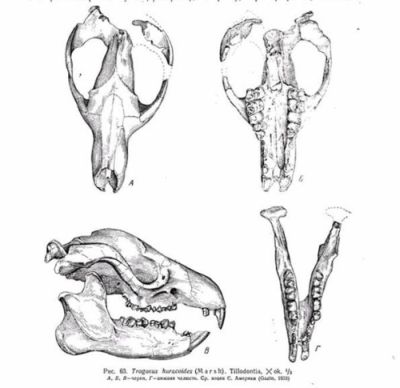
| Palaeos |  |
Archaic Mammals |
| Vertebrates | Tillodontia |
| Page Back | Unit Home | Unit References | Unit Cladogram | Taxon Index | Page Next |
| Unit Back | Vertebrates Home | Vertebrate Dendrograms | Vertebrate References | Glossary | Unit Next |
|
Abbreviated Dendrogram
EUTHERIA |?--+--Palaeoryctidae | `?--+--Pantolesta | `--Ptolemaiidae |?--+--Pantodonta | `--Tillodontia |?--Taeniodonta |?--Dinocerata |?==Creodonts |--BOREOEUTHERIA |--AFROTHERIA `--XENARTHRA |
Contents
Overview |
Taxa on This Page
 Restoration of Trogosus, a Middle Eocene tillodont the size and shape of a small bear (length 1.2 meters, weight about 150 kg (Kemp 2005)), via Zoologist ru - Tillodonts. For another reconstruction, showing a more lightly built animal, see Trogosus in a mural in the Smithsonian Museum painted by Jay Matternes, (complete image) MAK120316 |
The Tillodontia and the Taeniodonta are the oddballs of the Paleocene (and that's saying something in view of the eccentric fauna of the time) and are often described in teh same breath, but only because they are both early primitive large herbivores and their origins are so mysterious. And that their names begin with "T" and end with "odonts". It doesn't mean that they are necessarily related, although they may both be Cimolestans. Then again, they may not. The tillodonts were the more widespread of the pair, which perhaps means they were more successful. They seem to be related to pantodonts, or perhaps and an Asian origin from cimolestids. They were rooting and browsing forms with rodent-like incisors, clawed feet and blunt, cusped teeth. the largest, such as Trogosus, reached the size of a large bear. MAK111210

Tillodontia: Azygonyx, Esthonyx, Megalesthonyx, Plesiesthonyx,Trogosus
Range: Paleocene to Eocene of Asia, Europe and North America
Phylogeny: Placentalia/Crown Group Placentalia : Pantodonta + *
Image: Trogosus hyracoides Marsh 1873, Bridger Formation of Wyoming, via Zoologist ru - Tillodonts
| Page Back | Unit Home | Page Top | Page Next |
Page MAK120316